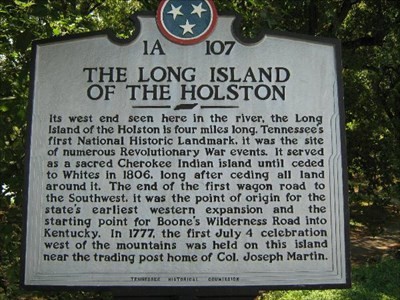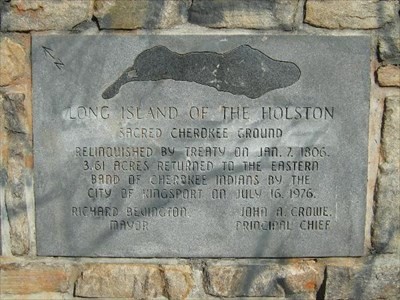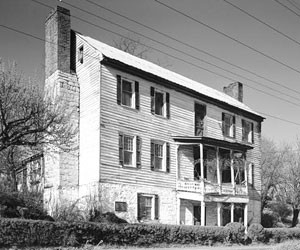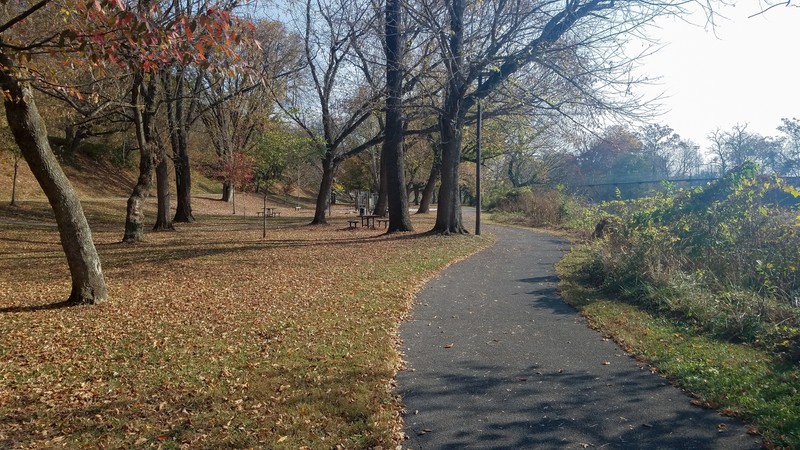Long Island of the Holston River Historical Marker
Introduction
Text-to-speech Audio
Images
An aerial view of Long Island of the Holston River, Tennessee's first National Historic Landmark

This historical marker shares a concise history of the Long Island of the Holston

This interpretive plaque also shares information about the Long Island of the Holston River

Netherland Inn, 1962

Domtar Park

Boatyard Riverfront Park

Backstory and Context
Text-to-speech Audio
In the centuries before the arrival of Europeans, Native Americans used the island for trade and meetings, including councils and treaty sessions. While there were few organized archeological explorations of the area in the centuries that followed, explorers and even modern residents have uncovered hundreds of artifacts such as arrowheads throughout the island. The region was used by Cherokee for hunting and what would become known as the Great Indian Warpath, or the Seneca Trail, further exemplifying the area’s significance in trade, diplomacy, and warfare.
In 1775, Daniel Boone, along with 30 men, was sent by Richard Henderson of the Transylvania Company, amid ongoing negotiations with Cherokees for tens of millions of acres of land, to initiate a trail leading into Kentucky. This trail, which began in March of 1775 on the Long Island of the Holston, two weeks before Boone and his men made their way to the Kentucky River, would become known as the Wildness Road. Over the next 20 years, the Wilderness Road was the path used by around 200,000 emigrants en route to Kentucky.
Following the Avery Treaty (also known as the Treaty of the Long Island of the Holston) in 1777 which followed a failed attempt to take this land from the Cherokee, Colonel Joseph Martin was chosen to be an Indian Agent on Long Island. Shortly after, he established a trading post which also functioned as his home for roughly a decade. It was at this trading post where one of the first ever July 4th celebrations west of the Appalachian Mountains took place that same year. Over time, Native control of the land was ceded to settlers as the balance of power shifted owing to increasing Native dependence on weapons and trade goods.
During the 19th century, the island was the location of the Richard Netherland family’s plantation which included several brick houses, mills, a shop, and a hemp factory. Other areas of the island were utilized as pastures, orchards, and cultivated fields. Aside from the restored Netherland Inn and Museum, which dates back to the early 19th century, none of the Netherland family buildings remain today.
In 1779, Colonel John Donelson and his men, in boats, journeyed along the Tennessee River and the Cumberland River, eventually finding what is known today as Cumberland County, one of the first permanent colonial settlements in middle Tennessee. Donelson’s expedition would come to serve as a model for following journeys westward by settlers. The model included traveling to Long Island to build flatboats and rafts, then continuing westward along the river. In 1802, a boatyard was established by men of William King of Virginia, and 20 years later the towns of Christianville and Rossville were combined to create today’s town of Kingsport.
The land is now recognized as a National Historic Landmark District. Across the South Fork of the Holston River from the north-western section of Long Island are historic sites of early settlers including Fort Robinson, the Netherland Inn Museum, and Boatyard Riverfront Park, each of which are listed on the National Register of Historic Places. The island’s eastern area mostly consists of residential developments and facilities like a fuel supply yard and an acetate plant. The middle portion of the island is divided amongst corporations and various private owners and has also been used for industrial developments. The western-most land of the island is now home to a multi-purpose community park called Domtar Park.
Sources
Dancer, Sachem Great Elk. "Treaty of Long Island of Holston." Red Door Casino. 1777. June 4, 2019. http://www.thereddoorcasino.com/notoweega/index.php/public-documents/139-the-treaty-of-long-island-of-holston-july-1777.
Dickinson, Calvin W. "Netherland Inn." Tennessee Encyclopedia. October 8, 2017. June 4, 2019. https://tennesseeencyclopedia.net/entries/netherland-inn/. last updated March 1, 2018.
"Domtar Park." Kingsport Parks and Recreation. June 4, 2019. https://www.kingsportparksandrecreation.org/domtar-park/.
Ezzell, Patricia Bernard. "Long Island." Tennessee Encyclopedia. October 8, 2017. June 4, 2019. https://tennesseeencyclopedia.net/entries/long-island/. last updated March 1, 2018.
Gale, Thomson. "Long Island of Holston." Encyclopedia. 2006. June 4, 2019. https://www.encyclopedia.com/history/encyclopedias-almanacs-transcripts-and-maps/long-island-holston. Encyclopedia of the American Revolution: Library of Military History.
Haywood, John. Civil and Political History of Tennessee (1823; reprint, Knoxville, 1970).
Kincaid, Robert L. “The Wilderness Road in Tennessee.” The East Tennessee Historical Society Publications 20 (1948): 38-48.
"Long Island of the Holston." National Park Service. June 4, 2019. https://www.nps.gov/parkhistory/online_books/colonials-patriots/sitec54.htm. last updated January 2005.
"Long Island, Kingsport, TN." World Island Info. February 20, 2009. June 4, 2019. https://www.flickr.com/photos/76074333@N00/11523602094/in/photostream/. Flickr.
"Long Island of the Holston, Kingsport TN." Waymarking. October 7, 2010. June 4, 2019. http://www.waymarking.com/waymarks/WM9WZ0_LONG_ISLAND_OF_THE_HOLSTON_Kingsport_TN.
Morris, Eastin, and Matthew Rhea. Eastin Morris' Tennessee Gazetteer, 1834, And Matthew Rhea's Map of the State of Tennessee, 1832. Nashville: Gazetteer Press, 1971 (c1834).
Neufeld, Rob. "Visiting Our Past: Long Island on the Holston, treaty to treatment." Citizen Times. October 28, 2018. June 4, 2019. https://www.citizen-times.com/story/life/2018/10/28/visiting-our-past-long-island-holston-treaty-treatment/1742555002/.
Owens, Anne Leslie. "John Donelson." Tennessee Encyclopedia. October 8, 2017. June 4, 2019. https://tennesseeencyclopedia.net/entries/john-donelson/. last updated March 1, 2019.
Summers, Lewis Preston. History of southwest Virginia, 1746-1786, Washington County, 1777-1870. Richmond, Va.. J. L. Hill printing company, 1903.
"The Long Island of the Holston." Waymarking. September 19, 2008. June 4, 2019. http://www.waymarking.com/waymarks/WM4QC0_The_Long_Island_of_the_Holston_1A_107_Kingsport_TN.
Toplovich, Ann. "Native American Trails." Tennessee Encyclopedia. October 8, 2017. June 4, 2019. https://tennesseeencyclopedia.net/entries/native-american-trails/. last updated March 1, 2018.
Williams, Samuel Cole, 1864-1947. Dawn of Tennessee Valley And Tennessee History. Johnson City, Tenn.: The Watauga press, 1937.
